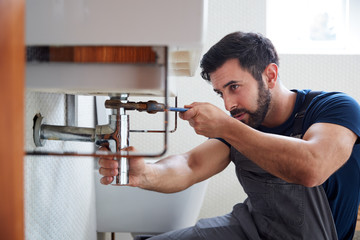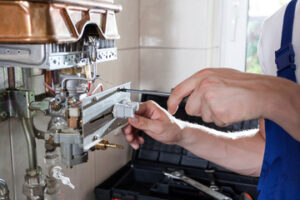The Woodlands Plumber install and repair pipes that carry water and waste into and out of homes and businesses. They also install plumbing fixtures and appliances such as bathtubs, sinks, and toilets.

Plumbers face many hazards on the job, including exposure to raw sewage, electricity, extreme temperatures, and manual tasks that increase the risk of musculoskeletal injuries. To help prevent injury, follow these safety tips:
Root invasions are the number one cause of sewer line backups. A clogged sewer line can lead to serious damage and expensive repairs. The problem can be caused by a variety of issues including sewage leaks, broken pipes or a blockage in the drain line. Regardless of the cause, the problem should always be dealt with as quickly as possible.
Any crack, separation or opening in the sewer line is a welcoming invitation for tree roots to enter. The roots are drawn to the nutrient rich water found inside the pipe and can grow rapidly invading and obstructing the lines.
Invasive roots can cause a host of problems for your plumbing system, from slow drainage to foul odors and even the potential for costly damage to your home’s foundation. The best way to deal with a root infestation is to prevent it in the first place. This can be done by careful landscaping where trees and bushes are planted and avoiding fast-growing species. In addition, a professional plumber can perform regular inspections with a specialized camera to spot any signs of infiltration.
If a root has already invaded your sewer line, a plumber should be called immediately to help prevent further damage and clogs. Some of the warning signs include excessive moisture around your property, slow draining, or gurgling sounds in your toilets and drains. A professional plumber can use a drain cleaning machine to remove the invading roots and prevent them from growing back.
A plumber should also be consulted about any recent landscaping or digging near the sewer line to make sure that the lines are not being affected. A plumber can consult with your local utility company to find out where the lines are buried and avoid any unnecessary excavation. Additionally, a professional plumber can inspect your sewer lines to see if there are any cracks or breaks that need to be repaired. If a crack or break is located, it can be fixed with minimal excavation by a plumber who is experienced in working on sewer lines. If the damage is too severe, it may be necessary to have a full repair done.
Vehicle Damage
Plumbing businesses often have a fleet of vehicles that employees use to transport equipment and materials between jobs. This creates significant automobile exposure for the business, as one accident can result in expensive damages and lost revenue. Commercial auto insurance policies may include coverage for collision damage, vandalism, flooding, hail damage, and more. These policies can also cover the cost of replacement or repair for any items stolen from the vehicle.
In addition to vehicle damage, plumbers may face other significant risks while on the job. For example, if a plumber is working under a sink and accidentally drops his or her tools in the water, it could cause severe injury or property damage. General liability insurance may provide coverage for third-party bodily injury or property damage claims that arise out of the plumber’s work activities.
Another important type of insurance for plumbers is commercial property insurance, which protects the business’s tools and other assets in case they are stolen or damaged. This type of policy can also help cover any repairs or losses incurred due to fire outbreaks, floods, or other natural disasters that impact the plumbing business’s workspace or equipment.
In addition to taking steps to reduce their risk of damage and injuries, plumbers should invest in proper training and safety protocols for their employees. This can help reduce the number of accidents that occur on the job, and it can also lower the cost of insurance premiums. Bundling several policies together, including general liability and workers’ compensation, can also help reduce the cost of plumbing insurance. This can make it more affordable to get the essential insurance coverage a plumbing company needs to thrive.
Clogged Toilets
If your toilets are constantly clogging, it’s important to contact a plumber. Constant clogs can damage your toilet, drains, and even the sewer line. If your clogs are minor, you can often resolve them with a plunger. If your clogs are more serious, they may require the use of a drain auger or other tools.
Most common clogs occur due to flushing non-flushable items down the toilet. These include feminine hygiene products, baby wipes, cotton balls, and other paper waste. Some foreign objects can also fall into the toilet, such as razor blades, toys, and other small debris. It’s a good idea to have small trashcans in your bathrooms for easy disposal of non-flushable items. Additionally, teaching children to not play in the toilet or flush toys can help prevent these clogs.
Hair is another common cause of clogged toilets. Over time, it can build up inside the toilet’s s-trap and cause a tough clog. Using a flanged plunger or a hand-held drain auger can dislodge this material. Alternatively, you can use a chemical clog remover that will corrode the clog and break it up.
Some clogs are caused by blockages in your drain lines. If your toilet drains and shower seem to clog at the same time, it’s likely because one or more of these drains are connected to the main sewer line. If the clog is severe, it could be blocking your entire sewer line and causing back ups throughout your home.
If you notice a white, calcified substance on your toilet or other drains, this is a sign of a major problem with your sewer system. Contact a plumber immediately to address the issue as soon as possible. Otherwise, the clog will continue to grow and could cause even more serious problems down the road. For the most effective maintenance, talk to a plumber about a sewer line protection service. This will keep your pipes from becoming damaged and prevent clogs from occurring in the future. A plumber will also recommend the best way to protect your sewer line based on your unique plumbing situation.
Appliances
A plumbing system is crucial for taking away waste, providing hot and cold water and regulating indoor climate. Plumbers install, repair and maintain these systems in residential and commercial buildings. They also ensure that plumbing fixtures like toilets, taps and showers are working properly. This job requires strong problem-solving skills because sometimes, a pipe may burst or the water heater might not be functioning.
Plumbers must also be familiar with local codes and regulations and be able to interpret blueprints and plans. They often collaborate with architects and construction teams to make sure that the plumbing systems in new buildings are integrated seamlessly. They may also need to work on large-scale plumbing projects, like sewage treatment plants and power plants.
The most common way for aspiring plumbers to get into the field is through apprenticeship programs that combine classroom instruction with on-the-job training. These programs typically last between four and five years. Licensed apprentices can expect to be paid for their work and can earn a journeyman plumber’s license after completing the program. Applicants should have a high school diploma or equivalent and be comfortable performing manual labor for long periods of time. They must also be able to read and understand complex diagrams of pipes, valves and fittings. Other essential skills include excellent customer service and the ability to troubleshoot problems. These skills are critical to ensuring that a plumber’s customers receive the best possible care and services. Plumbers are exposed to a variety of dangerous chemicals and materials, including lead, sulfur dioxide, silica, solvents, glues, solders and asbestos.
